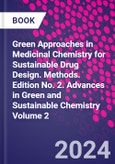Green Approaches in Medicinal Chemistry for Sustainable Drug Design: Methods, Second Edition reveals how medicinal chemistry can play a direct role in addressing this issue. After providing essential context on the growth of green chemistry in relation to drug discovery, the book identifies a range of practical techniques and useful insights, revealing how medicinal chemistry techniques can be used to improve efficiency, mitigate failure, and increase the environmental benignity of the entire drug discovery process. Drawing on the knowledge of a global experts, the book encourages the growth of green medicinal chemistry, and supports medicinal chemists, drug discovery researchers, pharmacologists, and more.
This volume covers synthesis methods following green chemistry principles, contributing to sustainability by saving energy, using lesser toxic reagents/solvents/catalysts and environmentally benign sources, including plants and agricultural materials.
Please Note: This is an On Demand product, delivery may take up to 11 working days after payment has been received.
Table of Contents
Nanotechnology
1. Nanocatalyzed Organic Transformations for Synthesis of Drug-Like Small Molecules With Medicinally Privileged Heterocycles
2. Nano Based Drug Delivery Of Anticancer Agents
3. Green Synthesis of silver nanoparticles for Antibacterial properties
4. Green Synthesis of Nanoparticles And Nanocomposites: Medical Aspect
5. Nanomaterials Mediated Synthesis Of ?-Lactams and Exploration Of Their Enhanced Biological Activities: Recent Advances
Combinatorial Chemistry
6. Green Combinatorial Chemistry in Medicinal Science
7. Combinatorial Chemistry in Cancer Drug Discovery
Energy
8. The Use of Ultrasound in Drug Synthesis: A Sustainable Method
9. Solar-powered Chemistry: New Catalytic Solutions for a Greener Planet
10. Photocatalytic Reactions for the Synthesis and Derivatization of Pharmaceutically Significant Heterocycles
11. Visible light-induced dye degradation potential of green synthesized Nanoparticles: An approach towards polluted water treatment
12. Green Synthetic Approach for Biologically Relevant Heterocyclic Compounds By Using Ball Mill
13. Synthesis of Natural Products by Photochemistry
14. Recent Magneto/Electrochemical/Bio-sensors and Analytical Approaches to Detect ?-Lactam Antibiotics in Food and Environment
Methods and Synthesis
15. Use of Sustainable Organic Transformations in the Construction of Heterocyclic Scaffolds
16. Diverse Synthesis of Medicinally Active Steroids
17. Solvent-Less Reactions: Green and Sustainable Approaches in Medicinal Chemistry
18. Versatile Thiosugars in Medicinal Chemistry
Microwave-Induced Chemistry
19. Microwave-Assisted Synthesis of Anti-tubercular Agents: A Novel Approach
20. Microwave-Induced Synthesis as a Part of Green Chemistry Approach for Novel Anti-inflammatory agents
Computers in Drug Discovery
21. Dipole Moment Studies on Beta Lactams
22. Computational Approaches For Development Of Anti-COVID-19 Agents
23. Dipole Moment in Medicinal Research: Green and Sustainable Approach
24. Computational Methods and Tools for Sustainable and Green Approaches in Drug Discovery








